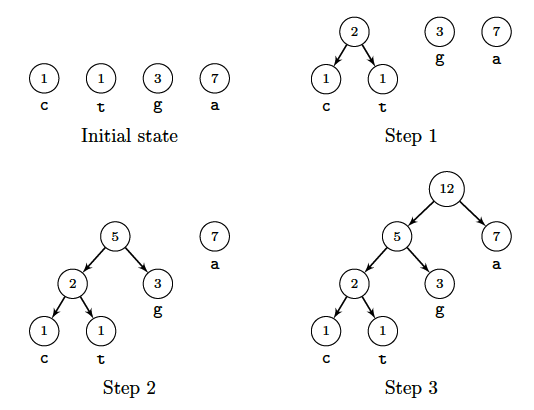Example
\(
\def\sa#1{\tt{#1}}
\def\dd{\dot{}\dot{}}
\newcommand{\hufflabel}{\mathit{label}}%
\newcommand{\alph}{\mathit{alph}}%
\newcommand{\freq}{\mathit{freq}}%
\newcommand{\code}{\mathit{code}}%
\newcommand{\result}{\mathit{result}}%
\)
Let $S=\{7,1,3,1\}$. Initially $\result=0$.
Step 1: $p=1$, $q=1$, $p+q=2$, $S=\{7,3,2\}$, $\result=2$.
Step 2: $p=2$, $q=3$, $p+q=5$, $S=\{7,5\}$, $\result=7$.
Step 3: $p=5$, $q=7$, $p+q=12$, $S=\{12\}$, $\result=19$.
The Huffman forest underlying the algorithm, which ends up with a Huffman
tree, is shown in the picture.
Nodes are labelled with weights.

The final tree provides codewords associated with letters,
summarised in the table.
| $\sa{a}$ | $\sa{c}$ | $\sa{g}$ | $\sa{t}$ |
| $\freq$ | 7 | 1 | 3 | 1 |
| $\code$ | $\sa{1}$ | $\sa{000}$ | $\sa{01}$ | $\sa{001}$ |
| $|\code|$ | 1 | 3 | 2 | 3 |
The cost of the tree is
$7\times 1 + 1\times 3 + 3\times 2 + 1\times 3=19$.
It is the length of the compressed word
$\sa{000}\;\sa{1}\;\sa{01}\;\sa{1}\;\sa{001}\;\sa{1}\;\sa{1}\;\sa{01}\;\sa{1}
\;\sa{01}\;\sa{1}\;\sa{1}$ corresponding to \sa{cagataagagaa}, whose letter
frequencies fit with those of the example.
Encoded with 8-bit codewords, the length of the latter word is $96$.

|
Problem 99: Cost of a Huffman Code
|

|
Huffman compression method applied to a text $x\in A^*$ assigns a binary
codeword to each letter of $x$ in order to produce a shortest encoded text.
Its principle is that the most frequent letters are given the shortest
codewords while the least frequent symbols correspond to the longest
codewords.
Codewords form a prefix code (prefix-free set) naturally associated with a
binary tree in which the links from a node to its left and right children are
labelled by $\sa{0}$ and $\sa{1}$ respectively.
Leaves correspond to original letters and labels of branches are their codewords.
In the present method
codes are complete: internal nodes of the tree all have exactly two children.
The cost of a Huffman code is the sum $\sum_{a\in A} \freq(a) \times
|\code(a)|$, where $\code(a)$ is the binary codeword of letter $a$.
It is the smallest length of a binary text compressed by the method
from a word $x$ in which $\freq(a)=|x|_a$ for each letter
$a\in\alph(x)$.
Let us consider the
following algorithm applied to frequencies (weights).
HuffmanCost$(S \textrm{ list of positive weights})$
\begin{algorithmic}
\STATE $result\leftarrow 0$
\WHILE{$|S|\gt 1$}
\STATE $p\leftarrow$ MinDelete$(S)$
\STATE $q\leftarrow$ MinDelete$(S)$
\STATE add $p+q$ to $S$
\STATE $result\leftarrow result+p+q$
\ENDWHILE
\RETURN{result}
\end{algorithmic}
Prove that Algorithm HuffmanCost$(S)$ computes the
smallest cost of a Huffman code from a list $S$ of item weights.
Consider the Huffman tree associated with the code/
Show how to implement algorithm HuffmanCost$(S)$ so that it runs in
linear time when the list $S$ is in increasing order.
Use a queue for inserting the new values (corresponding to internal
nodes of the tree).
References
D. A. Huffman. A method for the construction of minimum redundancy
codes. Proc. I.R.E., 40:1098-1101, 1951.
J. van Leeuwen. On the construction of Huffman trees. In ICALP, pages
382-410, 1976.



